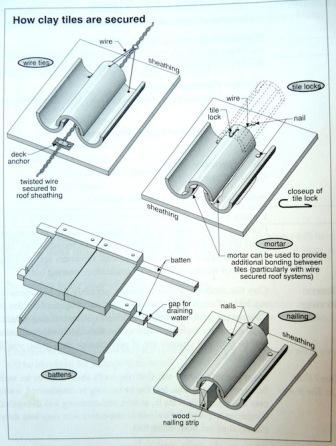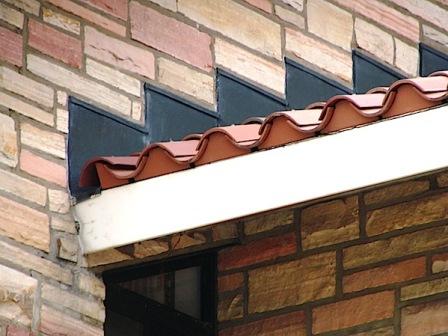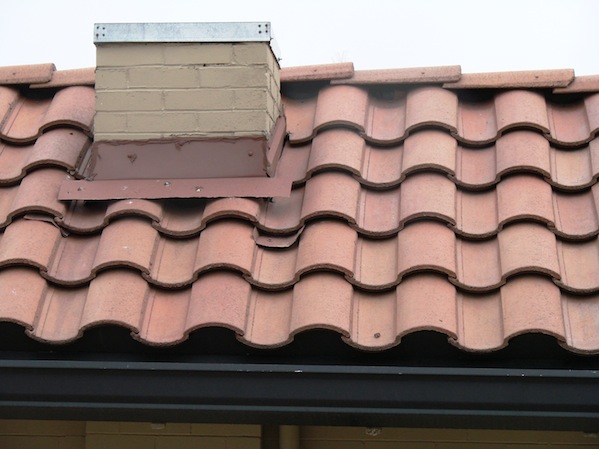Mastering Roof Inspections: Tile Roofs, Part 6
by Kenton Shepard and Nick Gromicko, CMI®
The purpose of the series “Mastering Roof Inspections” is to teach home inspectors, as well as insurance and roofing professionals, how to recognize proper and improper conditions while inspecting steep-slope, residential roofs. This series covers roof framing, roofing materials, the attic, and the conditions that affect the roofing materials and components, including wind and hail.
As with concrete tile, many installation methods have been used over the years for clay tile. Methods vary with tile design and local requirements.

Courtesy of Carson Dunlop
Tiles may be hung from wires, or nailed to battens or nailers. Tiles may also be held in place with mortar or a foam adhesive, especially ridge and hip cap tiles.
Roof Deck
Like concrete tiles, clay tiles can be installed on either a solid deck or spaced structural sheathing.
Tile Roof Flashing
Flashing methods vary with the type of tile. Most important is that the flashing method used prevents moisture intrusion.
Sidewall Flashing

Depending on the style of tile installed, sidewall flashing typically (but not always) includes a runoff channel.

This installer had to create custom sidewall flashing for this location. This tile should have some type of birdstop installed.

The photo above shows a good counter-flashing installation at the sidewall. Counter-flashing at brick and stone sidewalls is typically fastened with a sealant that needs to be maintained.
Headwall Flashing

This is a typical headwall flashing installation, except for the corners, which have had lead sheet installed and sealed against the fascia. Apparently, the pre-formed sheet metal wasn’t quite long enough.
You may also see tile headwalls with flashing formed to fit the tile.

You’ll see various methods used (some pretty ugly), such as this chimney flashing, which, ugly as it is, looks like it will do the job.
Hip Flashing

Hips are typically covered with cap tiles, but you may see them capped with metal. This is a different way of protecting a hip, but it looks effective as long as wind-driven rain can’t penetrate the gaps at the corners.
High-profile mission tiles should be installed with some type of weather-blocking at hips, ridges and headwalls. Weather-blocking may consist of metal, mortar, pre-formed plastic, pressure-sensitive adhesive rolls, or other material designed to prevent wind-driven rain, moisture and snowmelt from entering at these vulnerable areas.
Vent Flashing

It’s not unusual to see the lower edge of vent flashing bent to fit the contour of the tiles. Lead is sometimes used because it’s easier to bend to a specific shape. This tile was drilled to allow the installation of fasteners to help the sheet metal maintain its shape. The nail heads should be caulked to prevent moisture intrusion.
The white sealant around the pipe will need to be inspected on a regular basis and re-applied as needed.
Valley Flashing Fasteners
Because clay tile can have a long service life, fasteners used to attach it should have a similar length of service life. Fasteners should be stainless steel, copper, aluminum or hot-dipped galvanized steel, but not electroplated.
Clay Tile Inspection
Anytime you walk a clay tile roof, you risk breaking tiles. The resistance to breakage varies with the tile’s quality, profile and condition. Unless you are very familiar with a particular type of tile, it’s best to view the roof from a ladder at the roof edge, from a window or balcony, or through binoculars from the ground.

Sometimes, it’s hard to tell when an installation is actually failing, or to what degree it’s failing. The broken tiles you see on this roof obviously need replacement, but with this many layers, runoff may have a difficult time finding its way into the roof system. For a roof like this one, it’s best to recommend that a roof certification be performed by a qualified contractor.

It’s not what you’d call a clean roof, but, as you can see by the new roof in the photo above, this look is sometimes considered desirable.

Courtesy of Brian Kelley
Occasionally, you’ll see it taken to the extreme.
**************************************************
Learn how to master a roof inspection from beginning to end by reading the entire InterNACHI series: Mastering Roof Inspections.
Take InterNACHI’s free, online Roofing Inspection Course
Mastering Roof Inspections
Roofing Underlayment Types
Inspecting Underlayment on Roofs
Fall-Arrest Systems
Roofing (consumer-targeted)
More inspection articles like this

